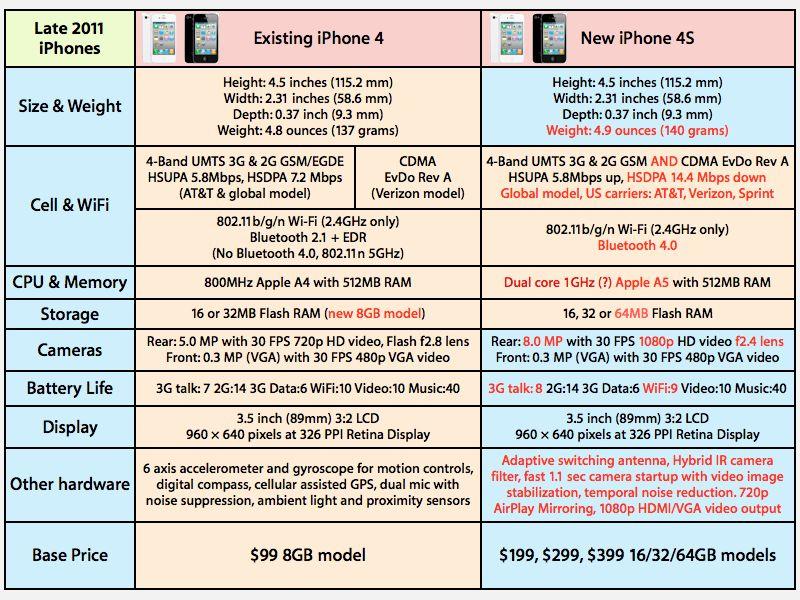iPhone 4S new 14.4 Mbps HSDPA 4G speeds won't help Americans
Apple's new iPhone 4S will take full advantage of foreign networks supporting 14.4 Mbps HSDPA (high speed downlink packet access), a technology related to the GSM/UMTS standards. The existing iPhone 4 is limited to 7.2 Mbps HSDPA and 5.76 HSUPA (uploads).
However, Verizon Wireless and Sprint, two of the three US mobile carriers will sell iPhone 4S in the US, are CDMA only, meaning they can't take any advantage of its new HSDPA speed potential. They'll continue to be limited to CDMA's 3G EVDO, which is noticeably slower than AT&T's network.
But even AT&T has been very conservative in building out its HSDPA capacity. The company's UMTS 3G network only started getting built out around 2006, when Verizon's competing, incompatible EVDO 3G service was already usable, initially forcing Apple to release the original iPhone as 2G only.
Apple has since increased the iPhone's 3G download speeds, first adding 7.2 HSDPA on the iPhone 3GS, then adding faster uploads with 5.76 Mbps HSUPA on iPhone 4, all the while also frequently noting that the potential of its smartphone was limited by the network technologies of carriers.
The company made similar caveats when introducing iPhone 4S with 14.4 Mbps HSDPA today. What it hasn't made clear is that not only will the feature only potentially address AT&T subscribers in the US, but that even AT&T's network has little or no support for actual 14.4Mbps service.
AT&T's HSDPA currently a tenth as fast as iPhone 4S potential
In a publicly issued document to mobile developers dated just last month, AT&T stated, "HSDPA—an ehhanced [sic] protocol in the HSPA family—is the highest-performance cellular-data technology ever deployed. Its peak theoretical rate is 14.4 megabits per second (Mbps).
"AT&T has engineered its network so that most users' experience typical downlink throughput rates of 700 kilobits per second (Kbps) to 1.7 Mbps, with bursts over 1 Mbps. Typical uplink rates are 500 Kbps to 1.2 Mbps."
The company notes that "Current HSDPA devices commonly support peak rates of 3.6 or 7.2 Mbps, though typical user rates are lower than this."
The existing iPhone 4 and iPhone 3GS fall into these categories, but iPhone 4S is now a 14.4 Mbps device. If AT&T continues to note that its actual network speeds are lower than the potential of last year's iPhones, then there isn't much hope that a faster iPhone will make any difference to Americans until AT&T improves the engineered throughput on its network.
The network that wasn't there
It's noteworthy that there is a 14.4 HSDPA mobile network in the US: it is being built out by T-Mobile. Unfortunately, it operates on frequencies that are incompatible with standard UMTS phones like Apple's iPhone 4S, making it also impossible to take advantage of the new phone's capabilities (just as existing 3G iPhones can't take advantage of the company's AWS 3G network, and are limited to 2G GSM service when unlocked to use T-Mobile).
AT&T hopes to finalize its acquisition plans of T-Mobile and convert the company's oddball AWS bands of HSDPA for future use as an LTE network, suggesting that America's primary 14.4 HSDPA network won't be around very long.
With iPhone 4S promising to be a very popular phone, AT&T has a strong opportunity to advertise its existing HSDPA speed advantage over CDMA rivals Sprint and Verizon, something that may compel the company to reconfigure its network engineering to fully support the faster speeds available to iPhone 4 (7.2 Mbps) and iPhone 4S users (14.4 Mbps).
Until that happens, however, a primary feature of the new iPhone 4S model will only really be useful to users in Europe, Asia and other locations with completed, fully functional high speed mobile data networks.
 Daniel Eran Dilger
Daniel Eran Dilger











 Mike Wuerthele
Mike Wuerthele
 Malcolm Owen
Malcolm Owen
 Chip Loder
Chip Loder

 William Gallagher
William Gallagher
 Christine McKee
Christine McKee
 Michael Stroup
Michael Stroup
 William Gallagher and Mike Wuerthele
William Gallagher and Mike Wuerthele






